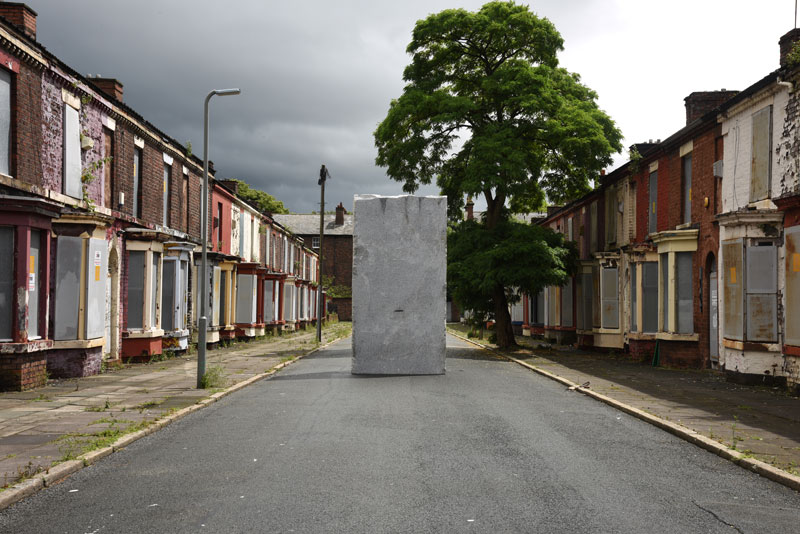To walk down Rhiwlas Street in Liverpool 8 is a pretty sobering experience. Most of the terraced Victorian houses sport signs that read: ‘ALL ITEMS OF VALUE HAVE BEEN REMOVED FROM THIS PROPERTY.’ They were all forcibly vacated some time ago, their windows and doors blocked with metal sheets. In the middle of the street stands an immense granite monolith created by Turinese artist Lara Favaretto. Its flank is slashed with what looks like a gun slit in a wartime bunker, into which punters are invited to drop loose change. At the end of the Liverpool Biennial, for which it was commissioned, Favaretto’s sculpture will be demolished and the collected money donated to a local charity that supports refugees. Noble as the gesture is, it is swallowed up by the enormity of the damage wreaked by decades of institutional neglect.
According to director Sally Tallant, this year’s Biennial ‘explores fictions, stories and histories, drawing on Liverpool’s past, present and future.’ At any other time, this would have sounded like so much curatorial guff, but in 2016, the year Britain was forced to confront itself and decide what kind of country it wanted to be, the narrative of place couldn’t be more prescient. ‘Where are you from?’, asks a slogan printed on the Biennial’s official tote bag. It is presumably intended as a welcoming gesture, but in light of the current national debate you could just as easily take it as an aggressive one.
With so many works sited in derelict or overlooked parts of town, it seems clear that this year’s Biennial was conceived as a sociopolitical as well as an artistic event. I had lazily assumed that, like so much of Britain’s Victorian housing stock, the abandoned buildings on Rhiwlas Street had been condemned to demolition, but it turns out the City of Liverpool has decided to leave them standing in the hope that they can once again be made habitable. What influence Assemble’s Turner Prize-winning redevelopment in nearby Toxteth’s Granby Four Streets has had, I don’t know. But when I visit that area it becomes clear that the architecture collective’s achievement is not the norm. In the shadow of another abandoned terrace, a sculpture by Alisa Baremboym stands as alien as a UFO on a scrappy patch of grass. Its near-conical surface is formed from sheets of punctured steel, similar to the ones lining the windows of the houses behind it. Looking between the perforations into the hollow interior, it’s possible to make out a pulsating pink light whose source remains hidden. I saw it in blazing sunshine, but to visit in the dark would be quite something.
Portal (2016), Rita McBride, installation view at Toxteth Reservoir, Liverpool Biennial 2016. Photo: Joel Chester Fildes
Meanwhile at the decommissioned Toxteth Reservoir – an extraordinary, bunker-like Victorian folly disguising a vast industrial space – Rita McBride has staged what is quite literally the Biennial’s most eye-scorching spectacle. The sign reading ‘Danger – Laser Radiation’ at the entrance is hard to shrug off, but it’s worth it. A cobweb of green laser beams shoot from one side of the structure to the other, the residual damp creating a twinkling effect on each gossamer thin ray.
Heading back to Lime Street Station through the city centre, I stopped by at the abandoned ABC cinema, a Grade II listed structure that screened its last film – Casablanca – in 1998 (by coincidence, the year of the first Liverpool Biennial). Walk in at the wrong moment and you’ll be enveloped by the darkness, before the room suddenly erupts into a barrage of psychedelic celluloid and eerie voiceovers.
This modest but grandiose space – check out the gilt depictions of Liverpool Cathedral still visible on the ceiling – is playing host to five different commissions. Sculptures by Favaretto, McBride and Ramin Haerizadeh, Rokni Haerizadeh and Hesam Rahmanian are scattered around the space, and are, frankly, a bit irrelevant to proceedings. But the two film installations by Samson Kambalu, whose monochrome films on multiple screens capture a group of children reimagining the aforementioned Casablanca, and the latest instalment of Fabien Giraud and Raphaël Siboni’s deranged The Unmanned series, turn this into the most anarchic, exciting arts venue in Britain right now. It really shouldn’t all work together, but it’s explosive.
The Unmanned (1922 – The Uncomputable) (film still; 2016), Fabien Giraud and Raphaël Siboni. Courtesy the artists
To come back to that question on the tote bag, I would imagine that, like me and indeed Assemble (who seem to me to be the unofficial godparents of this particular edition), many visitors would say they come from ‘elsewhere’. This, in the case of the Toxteth commissions, is problematic. Sceptics will no doubt interpret it all as an exercise in poverty tourism. Yet for all the controversy around ‘artist-led regeneration’ and its attendant pitfalls, Liverpool’s enthusiasm for it is heartening, and, I hope, successful. On the strength of what I saw, this Biennial is a uniquely ambitious and engaged art event. Let’s hope, in this time of instability, that Liverpool will have the opportunity to develop on that.
The Liverpool Biennial 2016 runs until 16 October at venues across the city.
